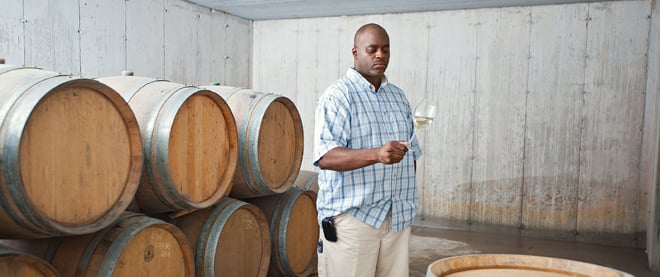Virtual wineries are making fine wine
They own neither land nor vines, but these vintners prove pedigree is not tied to property
Photograph by Cole Garside
Share

Charles Baker is amused to be referred to as a “virtual” winemaker. “I do exist,” he says. “My wine is real.” No argument there. Baker’s eponymous award-winning Vintner Quality Alliance (VQA) Riesling crafted from Niagara grapes is served at top restaurants across the country, including Vancouver’s Vij’s, as well as Terroir wine bars in New York City. It blows off liquor stores shelves: amassing a complete “vertical” of Charles Baker Picone Riesling from the first 2005 vintage to the latest 2010, at $35 a bottle, is a bragging point among wine geeks. But Baker is “virtual” in wine-speak because his is a brand without land or buildings: he works in the shadow of another winery’s licence, making and selling his two Rieslings through Stratus Vineyard in Niagara-on-the-Lake, Ont., where he’s the director of marketing and sales. The supportive relationship allows him to sidestep the Ontario law that requires winemakers to own a minimum of five acres of vineyards to sell wine—a threshold that rises to 20 acres in Niagara (in B.C., the minimum is two).
Baker, who has worked in the industry since 1994, is at the forefront of one of the most intriguing developments in Canadian wine since Inniskillin received its boutique licence in 1975. He’s among a growing tribe proving pedigree doesn’t hinge on property ownership. It’s a lesson learned in France in the 1980s when garagistes in Bordeaux upended the wine world with iconoclastic vins de garage produced in basements and outbuildings. More recently, cult wines like Brewer-Clifton, a California label produced by ex-surfer Steve Clifton and former French professor Greg Brewer in a prefab metal shed in an industrial park, are redefining “winery.” Paradoxically, Canada’s “virtual” movement pokes holes in the very land laws that created it: they were intended to protect quality by ensuring winemaking is tied to viticulture. Alas, owning vineyards doesn’t preclude winemakers from importing bulk grapes—or producing plonk. More, the trend brings a fresh blast of meritocracy; it opens the market to those with training and talent, if not the million or more needed to buy in Niagara. “You shouldn’t have to be rich to make great wine,” says Kevin Panagapka, who’s making a name producing 20-27 Cellars riesling, pinot noir and chardonnay at the Featherstone Winery in Lincoln, Ont. “You just need great grapes, great barrels, great technique.”
Another “virtual” up-and-comer, Steve Byfield, was studying jazz music at York University when a summer job at a DIY wine outlet changed his course: “I was bit by the wine bug,” he says. In 2009, after working at a string of wineries, he launched Nyarai, a label produced at Di Profio Wines in Jordan Station, Ont. Unlike Baker, who gives marquee status to individual vineyards and growers, or Panagapka, who buys rows of grapes and does the hand work himself, Byfield’s blends showcase grapes from the Niagara region. His Nyarai 2007 Veritas red was a big hit. Samples of his 2010 Cadence red, still in cask, are garnering big buzz.
Ian Clark, a sommelier at Toronto’s Scaramouche restaurant, notes “virtual” labels are popular with guests hosting visitors from abroad who want to show off local terroir and cool-climate viticulture. Limited supply also confers cachet, he says: “It’s like being in France and opening a local producer. You can’t get it across the border.”
Enterprising businesses are already capitalizing on the trend: Okanagan Crush Pad, a Summerland, B.C., shared wine facility geared to landless winemakers, opened in September 2011—to the chagrin of the established old guard. Baker likens the “virtual” and “bricks and mortar” divide, which is destined to grow, to food trucks operating near established restaurants. “I can see restaurants saying, ‘It’s not a level playing field—food trucks don’t have the same infrastructure costs yet are soaking up customers.’ My response is: so get a food truck.” But food trucks bring customers to a neighbourhood, just as “virtual” projects can, he says. Sommelier Clark agrees, noting “virtual” wines display confidence of an industry coming of age: “All that matters is what’s in the glass.” And that’s very real.